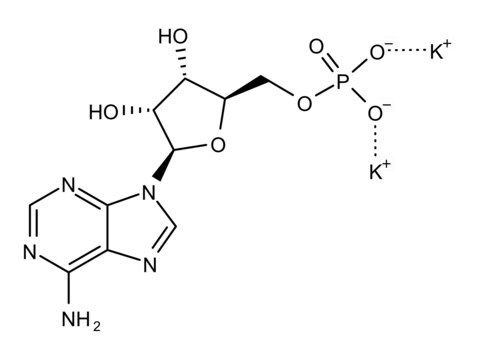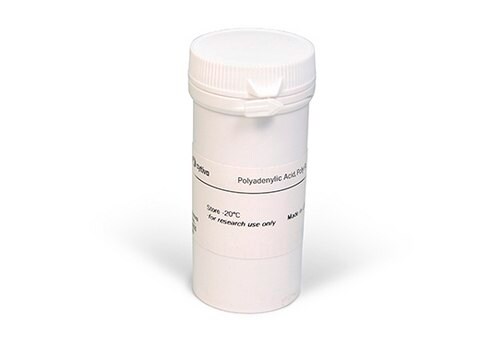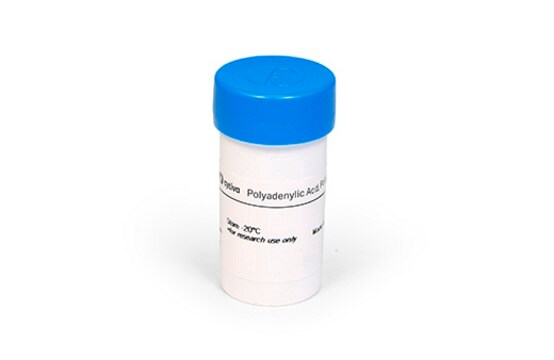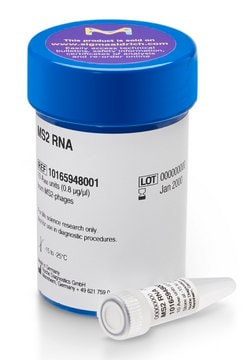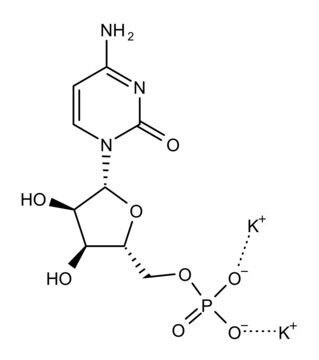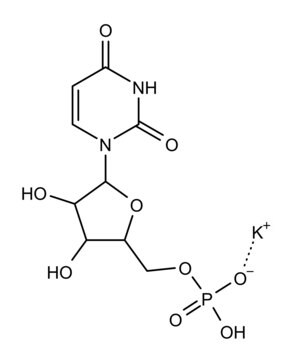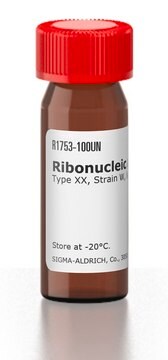Wszystkie zdjęcia(1)
Kluczowe dokumenty
10108626001
Roche
Poly(A)
lyophilized, suitable for PCR, pkg of 100 mg
Synonim(y):
Poly(A), Polyadenylic acid
Zaloguj sięWyświetlanie cen organizacyjnych i kontraktowych
About This Item
Kod UNSPSC:
41105600
Polecane produkty
opis
Polyadenylic acid
Poziom jakości
Formularz
lyophilized
masa cząsteczkowa
700-3500 kDa
opakowanie
pkg of 100 mg
producent / nazwa handlowa
Roche
stężenie
0.5 mg/mL (Working concentration)
metody
PCR: suitable
kolor
white
rozpuszczalność
water: soluble
stosunek absorbancji
A290/260 nm 0.03-0.05
A280/260 nm 0.28-0.32
A250/260 nm 0.86-0.90
temp. przechowywania
2-8°C
Opis ogólny
Poly(A) is used as a carrier for quantitative precipitation of DNA and RNA.
Zastosowanie
Poly(A) has been used for droplet digital PCR (ddPCR) assay.
Polyadenylic acid (Poly(A)) to inhibit Exo1′s exonuclease activity. It has also been used as a carrier to resuspend lyophilized gBlocks.
Działania biochem./fizjol.
Polyadenylic acid (Poly(A)) tails present at 3′ end are produced in the cell nucleus. It contains ~250 nucleotides in mammalian cells. Poly(A) regulates mRNA decay and the initiation of translation. Cytoplasmic poly(A) extension modulates translation.
Jakość
Typical analysis:
2.3μmol/mg Poly(A) (from absorbance) in relation to one mononucleotide unit. Chromatographically homogeneous.
Absorbance determination A250/A260, A280/A260, A290/A260
2.3μmol/mg Poly(A) (from absorbance) in relation to one mononucleotide unit. Chromatographically homogeneous.
Absorbance determination A250/A260, A280/A260, A290/A260
Sekwencja
Chain Length 2.100 to 10.000 nucleotides
Definicja jednostki
1 A260 unit corresponds to 40 μg ssRNA.
Postać fizyczna
Lyophilizate, potassium salt
Uwaga dotycząca przygotowania
Working concentration: 0.5 mg/ml
A concentration of 0.5 mg/ml is recommended.
Working solution: 0.5 mg/ml is recommended.
A concentration of 0.5 mg/ml is recommended.
Working solution: 0.5 mg/ml is recommended.
Inne uwagi
For life science research only. Not for use in diagnostic procedures.
Ta strona może zawierać tekst przetłumaczony maszynowo.
Kod klasy składowania
11 - Combustible Solids
Klasa zagrożenia wodnego (WGK)
WGK 1
Temperatura zapłonu (°F)
Not applicable
Temperatura zapłonu (°C)
Not applicable
Wybierz jedną z najnowszych wersji:
Masz już ten produkt?
Dokumenty związane z niedawno zakupionymi produktami zostały zamieszczone w Bibliotece dokumentów.
Poly (A) tail length is controlled by the nuclear poly (A)-binding protein regulating the interaction between poly (A) polymerase and the cleavage and polyadenylation specificity factor
Kuhn U, et al.
The Journal of Biological Chemistry, 284(34), 22803-22814 (2009)
Yuichiro Miyaoka et al.
Scientific reports, 6, 23549-23549 (2016-04-01)
Precise genome-editing relies on the repair of sequence-specific nuclease-induced DNA nicking or double-strand breaks (DSBs) by homology-directed repair (HDR). However, nonhomologous end-joining (NHEJ), an error-prone repair, acts concurrently, reducing the rate of high-fidelity edits. The identification of genome-editing conditions that
Poly (ADP-ribose)-binding promotes Exo1 damage recruitment and suppresses its nuclease activities
Cheruiyot A, et al.
DNA Repair, 35, 106-115 (2015)
Peiguo Yang et al.
Cell, 181(2), 325-345 (2020-04-18)
The mechanisms underlying ribonucleoprotein (RNP) granule assembly, including the basis for establishing and maintaining RNP granules with distinct composition, are unknown. One prominent type of RNP granule is the stress granule (SG), a dynamic and reversible cytoplasmic assembly formed in
Nasz zespół naukowców ma doświadczenie we wszystkich obszarach badań, w tym w naukach przyrodniczych, materiałoznawstwie, syntezie chemicznej, chromatografii, analityce i wielu innych dziedzinach.
Skontaktuj się z zespołem ds. pomocy technicznej